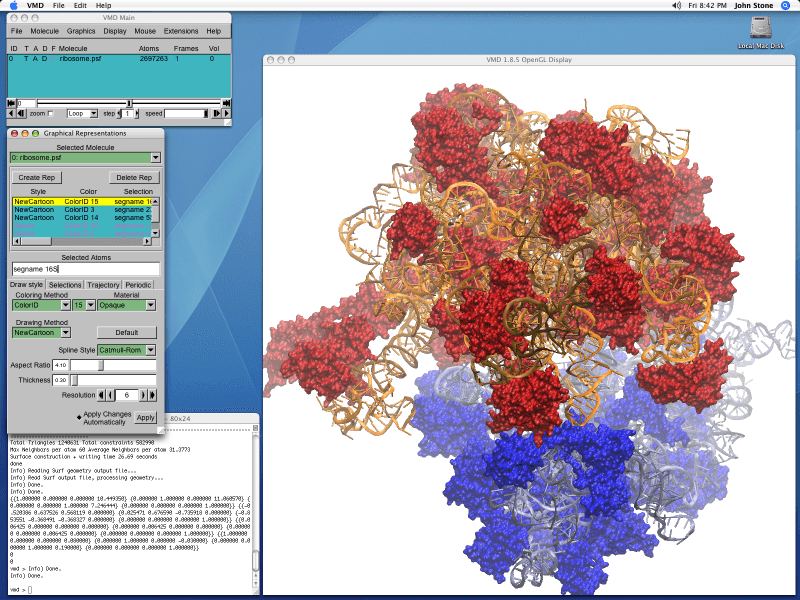VMD is a molecular visualization program for displaying, animating, and analyzing large biomolecular systems using 3-D graphics and built-in scripting.
It can be used to view more general molecules, as VMD reads standard Protein Data Bank (PDB) files and display the contained structure. VMD provides a wide variety of methods for rendering and coloring molecule.
VMD can be used to animate and analyze the trajectory of molecular dynamics (MD) simulations, and can interactively manipulate molecules being simulated on remote computers (Interactive MD).
Features include:
- Support for GPU accelerated computation.
- No limits on the number of molecules, atoms, residues or number of trajectory frames, except available memory.
- Rendering mode which supports scene capture with Adobe Acrobat3D, allowing researchers to create PDF documents containing 3-D scenes from VMD.
- Many molecular rendering and coloring methods including support for high-quality molecular scene rendering using Tachyon, NVIDIA Gelato, and PIXAR RenderMan.
- Stereo display capability.
- Extensive atom selection syntax for choosing subsets of atoms for display (includes boolean operators, regular expressions, and more).
- Support for over 60 molecular file formats and data types through an extensive library of built-in file reader/writer plugins and translators VMD includes a multiple sequence alignment plugin, a unified bioinformatics analysis environment that allows one to organize, display, and analyze both sequence and structure data for proteins and nucleic acids.
- Ability to export displayed graphics to files which may be processed by a number of popular ray tracing and image rendering packages, including POV-Ray, Rayshade, Raster3D, and Tachyon.
- User-extensible graphical and text-based user interfaces, built-on standard Tcl/Tk and Python scripting languages.
- Extensions to the Tcl language which enable researchers to write their own routines for molecular analysis.
- Modular, extensible source code using an object-oriented design in C++, with a programmers guide describing the program architecture and source code.
- Integration with the program NAMD, a fast, parallel, and scalable molecular dynamics program.
- VMD tutorials developed locally, and by the research community at large.
Website: www.ks.uiuc.edu/Research/vmd
Support: Documentation
Developer: University of Illinois at Urbana-Champaign
License: Freeware

VMD is written in C++. Learn C++ with our recommended free books and free tutorials.
Return to Scientific | Return to Biology Tools
| Popular series | |
|---|---|
| The largest compilation of the best free and open source software in the universe. Each article is supplied with a legendary ratings chart helping you to make informed decisions. | |
| Hundreds of in-depth reviews offering our unbiased and expert opinion on software. We offer helpful and impartial information. | |
| The Big List of Active Linux Distros is a large compilation of actively developed Linux distributions. | |
| Replace proprietary software with open source alternatives: Google, Microsoft, Apple, Adobe, IBM, Autodesk, Oracle, Atlassian, Corel, Cisco, Intuit, and SAS. | |
| Awesome Free Linux Games Tools showcases a series of tools that making gaming on Linux a more pleasurable experience. This is a new series. | |
| Machine Learning explores practical applications of machine learning and deep learning from a Linux perspective. We've written reviews of more than 40 self-hosted apps. All are free and open source. | |
| New to Linux? Read our Linux for Starters series. We start right at the basics and teach you everything you need to know to get started with Linux. | |
| Alternatives to popular CLI tools showcases essential tools that are modern replacements for core Linux utilities. | |
| Essential Linux system tools focuses on small, indispensable utilities, useful for system administrators as well as regular users. | |
| Linux utilities to maximise your productivity. Small, indispensable tools, useful for anyone running a Linux machine. | |
| Surveys popular streaming services from a Linux perspective: Amazon Music Unlimited, Myuzi, Spotify, Deezer, Tidal. | |
| Saving Money with Linux looks at how you can reduce your energy bills running Linux. | |
| Home computers became commonplace in the 1980s. Emulate home computers including the Commodore 64, Amiga, Atari ST, ZX81, Amstrad CPC, and ZX Spectrum. | |
| Now and Then examines how promising open source software fared over the years. It can be a bumpy ride. | |
| Linux at Home looks at a range of home activities where Linux can play its part, making the most of our time at home, keeping active and engaged. | |
| Linux Candy reveals the lighter side of Linux. Have some fun and escape from the daily drudgery. | |
| Getting Started with Docker helps you master Docker, a set of platform as a service products that delivers software in packages called containers. | |
| Best Free Android Apps. We showcase free Android apps that are definitely worth downloading. There's a strict eligibility criteria for inclusion in this series. | |
| These best free books accelerate your learning of every programming language. Learn a new language today! | |
| These free tutorials offer the perfect tonic to our free programming books series. | |
| Linux Around The World showcases usergroups that are relevant to Linux enthusiasts. Great ways to meet up with fellow enthusiasts. | |
| Stars and Stripes is an occasional series looking at the impact of Linux in the USA. | |
